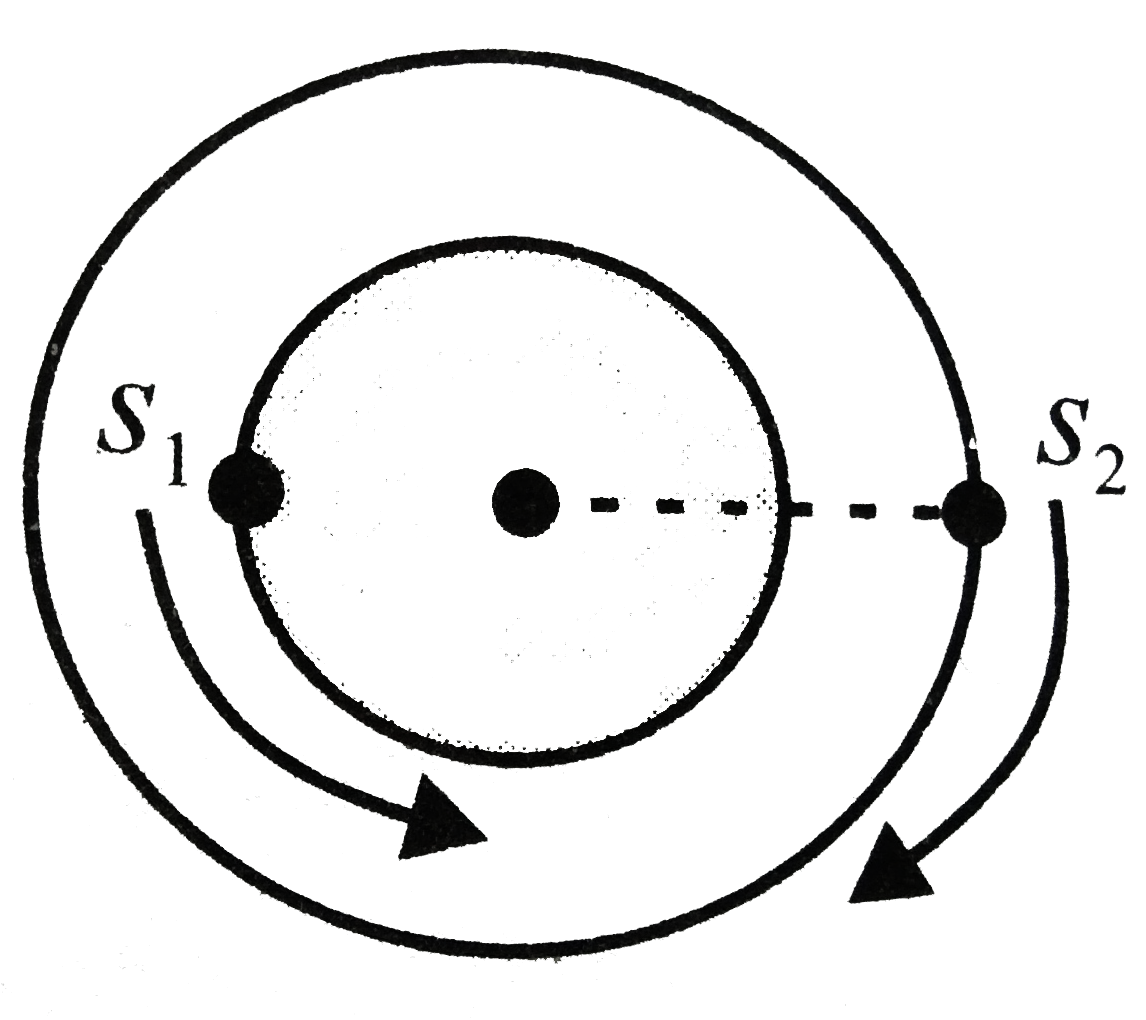Two satellite S1andS2 revolve round a planet in coplanar circular orbits in the same sense. Their periods of revolutions are 1 h nd 8 h respectively. The radius of the orbit of S1 is 104km. When S2 is closet to S1., find (a). The speed of S2 relative to S1 and (b). the angular speed of S2 as observed by an astronaut in S1.
To solve the problem, we will follow these steps:
Step 1: Determine the radius of the orbit of satellite S2 using Kepler's Third Law.
According to Kepler's Third Law, the square of the period of revolution (T) is proportional to the cube of the radius (r) of the orbit:
r32r31=T22T21
Given:
- T1=1 hour
- T2=8 hours
- r1=104 km
Substituting the values:
r32(104)3=(81)2=64
This gives:
r32=64×(104)3
Taking the cube root:
r2=4×104 km
Step 2: Calculate the linear speed of satellite S1.
The linear speed V1 of satellite S1 can be calculated using the formula:
V1=2πr1T1
Substituting the values:
V1=2π(104)1 hour=2π×104 km/hour
Step 3: Calculate the linear speed of satellite S2.
Similarly, the linear speed V2 of satellite S2 is given by:
V2=2πr2T2
Substituting the values:
V2=2π(4×104)8 hours=2π×4×1048=π×104 km/hour
Step 4: Calculate the relative speed of S2 with respect to S1.
Since both satellites are moving in the same direction, the relative speed Vrel of S2 with respect to S1 is:
Vrel=V2−V1
Substituting the values:
Vrel=(π×104)−(2π×104)=−π×104 km/hour
Since we are interested in the magnitude:
Vrel=π×104 km/hour
Step 5: Calculate the angular speed of S2 as observed by an astronaut in S1.
The relative angular speed ωrel can be calculated using the formula:
ωrel=Vrelr2−r1
Substituting the values:
ωrel=π×104(4×104)−(104)=π×1043×104=π3 rad/hour
Final Answers:
(a) The speed of S2 relative to S1 is π×104 km/hour.
(b) The angular speed of S2 as observed by an astronaut in S1 is π3 rad/hour.
---
- T1=1 hour
- T2=8 hours
- r1=104 km
Topper's Solved these Questions
- GRAVITATIONBOOK - HC VERMA ENGLISHCHAPTER - GRAVITATIONEXERCISE - Objective -1
16 Videos
- GRAVITATIONBOOK - HC VERMA ENGLISHCHAPTER - GRAVITATIONEXERCISE - Objective -2
6 Videos
- GRAVITATIONBOOK - HC VERMA ENGLISHCHAPTER - GRAVITATIONEXERCISE - Question for short Answers
18 Videos
- FRICTIONBOOK - HC VERMA ENGLISHCHAPTER - FRICTIONEXERCISE - Questions for short Answer
11 Videos
- HEAT AND TEMPERATUREBOOK - HC VERMA ENGLISHCHAPTER - HEAT AND TEMPERATUREEXERCISE - Objective 2
6 Videos
Similar Questions
Two satellites S1 and S2 revolve round a planet in coplaner circular orbit in the same sense. Their period of revolution are 1 hour and 8 hour respectively. The radius of the orbit of S1 is 104km. When S2 is closest to S1, find
(a) The speed of S2 relative to S1,
(b) The angular speed of S2 actually observed by an astronaut is S1
View SolutionTwo satellites S1 and S2 are revolving round a planet in coplanar and concentric circular orbit of radii R1 and R2 in te same direction respectively. Their respective periods of revolution are 1 hr and 8 hr. the radius of the orbit of satellite S1 is equal to 104km. Find the relative speed in kmph when they are closest.
View Solution
Knowledge Check
Two satellites S1 and S2 revolve around a planet in coplanar circular orbits in the same sense their periods of revolution are 1 hour and 8hours respectively the radius of the orbit of S1 is 104 km when S1 is closest to S2 the angular speed of S2 as observed by an astronaut in S1 is :
Aπ×104B−π×104Cπ×105Dπ×105In the above example the angular velocity of S2 as actually observed by an astronaut in S1 is -
A3×10−4B3×1023C3×10−6D3×10−7
Two satellites S1 and S2 are revolving around the earth in coplanar concentric orbits in the opposite sense. At t=0, the position of satellites are shown in the diagram. The periods of S1 and S2 are 4h and 24h, respectively. The radius of orbit of S1 is 1.28×104km. For this situation, mark the correct statement (s).

View SolutionTwo satellities s1 a & s2 of equal masses revolves in the same sense around a heavy planet in coplaner circular orbit of radii R & 4R
View SolutionTwo satellites S1 and S2 revolve around the earth at distances 3R and 6R from the centre of the earth. Find the ratio of their (a) linear speeds and (b) angular speeds.
View SolutionA satellite is revolving round the earth in a circular orbit with a velocity of 8km/s. at a height where acceleration due to gravity is 8m/s2. How high is the satellite from the earth ? (Take R = 6000 km)
View SolutionThe Velocity of four gas molecules are given by 1 km/s, 2 km/s, 6 km/s and 8 km/s respectively. The rms velocity is
View SolutionOrbital radius of a satellite S of earth is four times that s communication satellite C. Period of revolution of S is :-
View Solution